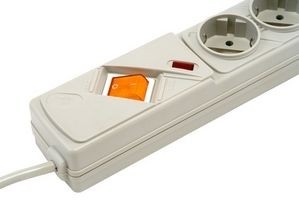Safety Hazards Of Extensions On Power Strips

Using extension cords and power strips is a convenient way to get electricity to where it is needed when no electrical outlet is nearby. However, improper use of extension cords on power strips can cause fires, electrical shocks or burns and equipment damage, according to the National High Magnetic Field Laboratory. Every year an estimated 4,000 people are treated for injuries in hospital emergency rooms and some 3,300 residential fires occur because of faulty extension cords, according to the U.S. Consumer Product Safety Commission.
Exceeding Power Strip Wattage
Inspect the wattage of everything plugged into the power strip, which is especially important when extension cords have more than one electrical item plugged into them. Add up the total wattage of all items plugged into the power strip. Do not exceed the total electrical wattage the power strip is rated to handle to avoid the hazards of a fire or damage to the electrical equipment plugged into the strip.
Damaged Cords
Do not use a power strip or extension cords with any damage, including cuts or exposed wires, and do not place cords where they can suffer damage during use. Touching a single exposed wire can cause an electrical shock or burn, according to the National High Magnetic Field Laboratory. Damaged wiring on extension cords or power strips can also cause fires.
Tripping and Mouth Burns
Extension cords plugged into power strips can create a safety hazard. Every year, an estimated 2,000 people trip over extension cords and suffer injuries that are serious enough to require a trip to a hospital emergency room. Injuries include such things as lacerations, contusions, sprains and fractures. About half of those injured are children under the age of 5, who also suffer electrical burns to the mouth, according to the U.S. Consumer Product Safety Commission.
High Power Loads
Do not use extension cords on power strips for high power loads, such as microwave ovens, refrigerators or space heaters, according to the Occupational Safety and Health Administration (OSHA). Power strips are for use with low-powered loads such as computers, peripherals and audio or visual equipment, OSHA says.
UL Rated
Make sure the extension cords and power strip are approved by the Underwriters Laboratory and have a UL rating. Sometimes extension cords and power strips that are not UL rated do not have a sufficient protective coating over the wires, and electrical shocks, burns or fires can result.
Exceeding Power Strip Wattage
Inspect the wattage of everything plugged into the power strip, which is especially important when extension cords have more than one electrical item plugged into them. Add up the total wattage of all items plugged into the power strip. Do not exceed the total electrical wattage the power strip is rated to handle to avoid the hazards of a fire or damage to the electrical equipment plugged into the strip.
Damaged Cords
Do not use a power strip or extension cords with any damage, including cuts or exposed wires, and do not place cords where they can suffer damage during use. Touching a single exposed wire can cause an electrical shock or burn, according to the National High Magnetic Field Laboratory. Damaged wiring on extension cords or power strips can also cause fires.
Tripping and Mouth Burns
Extension cords plugged into power strips can create a safety hazard. Every year, an estimated 2,000 people trip over extension cords and suffer injuries that are serious enough to require a trip to a hospital emergency room. Injuries include such things as lacerations, contusions, sprains and fractures. About half of those injured are children under the age of 5, who also suffer electrical burns to the mouth, according to the U.S. Consumer Product Safety Commission.
High Power Loads
Do not use extension cords on power strips for high power loads, such as microwave ovens, refrigerators or space heaters, according to the Occupational Safety and Health Administration (OSHA). Power strips are for use with low-powered loads such as computers, peripherals and audio or visual equipment, OSHA says.
UL Rated
Make sure the extension cords and power strip are approved by the Underwriters Laboratory and have a UL rating. Sometimes extension cords and power strips that are not UL rated do not have a sufficient protective coating over the wires, and electrical shocks, burns or fires can result.
- mj3cb42ada7485b660ef3843035e233d96.jpg
References
http://www.ehow.com/list_7464100_safety-hazards-extensions-power-strips.html
http://img.ehowcdn.com/615x200/ehow/images/a07/3p/54/safety-hazards-extensions-power-strips-1.1-800x800.jpg